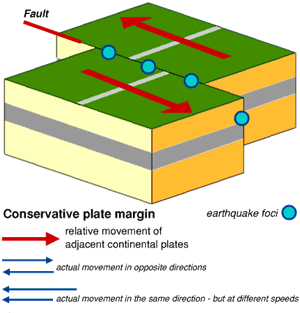- Away from each other (divergent/constructive)
- Towards each other, with one going under the other (convergent/destructive)
- Sliding alongside each other (conservative/transform)
Divergent/Constructive Boundaries
- What happens at these boundaries:
- To "diverge" literally means to go away from one another, so "divergent" plates do exactly that
- They are also considered constructive, because this type of boundary brings mantle to the surface, "constructing" more crust...when in the ocean, this is known as seafloor spreading
- New magma from the mantle rises to the surface to fill the gap between the moving plates
- It is runny lava, which pours out almost continuously in a non-violent way, and cools to form basalt
- This lava forms volcanoes with wide bases and gentle sides
- What happens as a result of this action:
- Rift valleys are formed along faults caused by the crust splitting as the two plates move apart. (Ex. East African Rift)
- In the ocean, rift valleys result in oceanic ridges. (Ex. Mid-Atlantic Ridge)...really cool...underwater mountains!!!
- Volcanoes and earthquakes can result from divergent plate boundaries
- The following graphic shows the formation of a continental rift valley, a continental rift valley turning into a new body of water, and an oceanic rift valley (ridge)
- What happens at these boundaries:
- To "converge" literally means to go come together, so "convergent" plates do exactly that
- They are also considered destructive, because this type of boundary brings crust back to the mantle, thus "destructing" it
- Usually occurs at oceanic/continental plate boundaries
- One plate, usually the oceanic plate (because it is more dense), sinks below the other
- It is destroyed in the subduction zone
- The subduction zone is the area where the oceanic plate slips under the continental plate
- Sediments on the sea bed between the two plates are compressed and folded up to form the world's high mountain ranges (ex. Himalayas, Rockies)
- The friction from plate movement in the subduction zone makes the rocks melt
- This produces magma from which volcanoes are formed
- What happens as a result of this action:
- These volcanic eruptions can be violent as the lava is shattered into many pieces by explosions, and thrown out as rocks, ash, and other debris
- Tall, steep-sided cones are built up (see picture of Osorno Volcano in Chile to the right)
- Earthquakes are frequent; the ground shakes from the forced movement of rock against rock
- The following graphic shows a typical convergent boundary forming volcanoes on the continent
Click here for an animation of a convergent plate boundary
- A rather unique occurrence of a convergent boundary forms the Rocky Mountains, including the Grand Teton range and unique geothermal features at Yellowstone. These features are very far inland...not what you'd expect. The reason being that the subducting lithosphere plate ends up going more horizontal, creating heat changes, and thus mountains and volcanic activity well inland. A fault (crack in the Earth) combine with this movement gives rise to the majestic Grand Teton mountains. The following video animation shows this process. Yellowstone also is over a 'Hot Spot,' which you can see more about in that section below.
Conservative/Transform Boundaries
- What happens at these boundaries:
- The plates slide against each other, neither creating new crust nor destroying it....movement that "conserves" the crust that is in place
- They may be moving in the same direction, at different speeds, or in opposite directions
- Stresses build up, which are then released by occasional, sudden plate movements
- Friction caused by rock rubbing against rock forms earthquakes
- What happens as a result of this action:
- Earthquakes...fault likes (Ex. San Andreas Fault)
- Landslides, fires, and other destructive forces can be the result of earthquakes caused by conservative boundary shift
- The following graphic shows an example of a conservative boundary
Hot Spots
The last phenomena you need to know about in this part are called hot spots. Hot spots aren't really the result of plate movement...they can be at a plate boundary, near one, or far from one. They are theorized to be the result of extra-hot mantle pockets that push their way to the surface. They can result in things such as volcanic islands and geysers. Two great examples of these are the Hawaiian Islands and the Yellowstone Caldera and resulting Geysers, both in the middle of plates. The spread of the land masses will happen as the plate the hot spot is under moves, but the hot spot remains stationary, like in the Hawaiian example shown here:




No comments:
Post a Comment